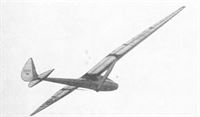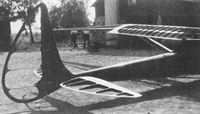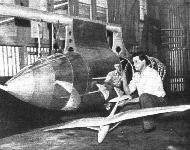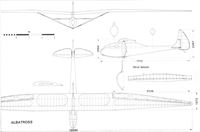
M.Simons The World's Vintage Sailplanes 1908-45
THE BOWLUS ALBATROSS
In 1930 William Hawley Bowlus, who had already several successful sailplane designs to his credit, closed his small factory in California and went to New York, where he was associated with Martin Schempp and Gus Haller in the Haller-Hirth Sailplane Manufacturing Company. Richard du Pont encouraged him to continue designing sailplanes of his own and Bowlus returned to California and announced lhe Bowlus Super Sailplane, with a span of 18.29 metres (60 ft). The aircraft was built by students of the Curtiss-Wright Technical Institute at Glendale. Schempp reported it as having a glide ratio of 20 : 1 and a minimum rate of sink of .60 m sec. The wing profile was Goettingen 549, tapering to a thin symmetrical profile at the tip, very similar in fact to lhe wing of Kronfeld's famous Wien.
The wing had no dihedral and was mounted on a high pylon. The outer wing panels were sharply tapered in planform and the trailing edges of the long, narrow ailerons curved to give an outline which was approximately elliptical. There were external struts. Bowlus made these like small, auxiliary wings. They had a symmetrical aerofoil-shaped cross-section and ribs with fabric covering. At their lower end these wing-like struts were not attached to the main fuselage frame but were bolted directly to lhe bearings of the landing wheel. The wheel was itself an original feature, for almost all gliders previously had only a skid undercarriage.
The cockpit followed German practice, an opaque wooden canopy enclosing head and shoulders with portholes on either side. At the rear the fuselage tapered to a slender boom carrying all-moving pendulum elevators and a rudder of curved outline on a small stub fin. A steel spring skid protected the rudder where it projected below the line of the fuselage. All the fittings were of heat treated, chrome molybdenum steel, and cadmium-plated to resist corrosion. Rigging and de-rigging were easy, assembly taking three men only ten minutes.
This was the most advanced sailplane in the USA and Warren Eaton, a founder member of the Soaring Society of America, ordered another from Bowlus, with improvements. The result was the Albatross 1, christened Falcon. Compared with lhe Super Sailplane, the Falcon was 0.61 m greater in span with a slightly higher aspect ratio and greater wing area. The wing was given a slight ‘gull’ form of dihedral after the German fashion. Probably because the Super Sailplane had proved somewhat too flimsy in service, the Falcon was heavier and stronger, and the wing loading was higher, but in all other respects, such as the fuselage shape, struts, wheel, and cockpit canopy, it was identical to the earlier type. Bowlus was already thinking well ahead of his contemporaries. The Falcon had split trailing edge flaps on the inner wing panels. Cranked down by the pilot, these increased the drag and lowered the stalling speed for landing. A notable feature was that the plywood used for covering was mahogany rather than birch or spruce, which gave the varnished sailplane an air of luxury. Added to its graceful lines this made it one of the most beautiful sailplanes in the world. It was in the east that the Falcon made all its greatest flights.
The Albatross 2 was built for Richard du Pont, Bowlus’ financial backer. It was identical to Warren Eaton’s aircraft except that the landing flaps were omitted and the skinning plywood was spruce instead of mahogany. Having taken delivery of his sailplane early in 1934, Richard du Pont quickly established himself as the leading soaring pilot in the USA. On 25th June he took off from Harris Hill and with a following wind soared away eastward. After many adventures du Pont was amazed and delighted to come within sight of the skyscrapers of Manhattan, and he landed at a small aerodrome close to the suburbs of New York City, 247 km from Harris Hill. It was a new world distance record, although disallowed by a technicality. Du Pont was the first person outside Europe to come anywhere near the world distance record. A few weeks later du Pont, this time flying the Albatross 1 (Falcon), reached 1897 metres and set the US altitude record, becoming the second American pilot to complete his Silver ‘C’, the first being Jack O'Meara. Du Pont’s badge was number 32 on the international list.
The Albatross I (Falcon) today is in the Smithsonian Institute. The Albatross 2 also survives. After three times winning the US National Championships, twice when flown by Richard du Pont and in 1936 with a new pilot, Chet Decker, the sailplane was retired from use and stored. For more than forty years it was unheard of but was at last re-discovered at a country aerodrome, in a hangar roof, and Decker, whose title to the aircraft was still valid, donated it to the National Soaring Museum at Elmira, for restoration.
Technical data:
Albatross 2: Span. 18.85 m. Wing area. 19.1 sq m. Aspect ratio. 18.72. Flying weight. 226 kg. Wing loading. 11.8kg/sqm. Aerofoil. Goettingen 549 at the root, with thin symmetrical tip.
- M.Simons The World's Vintage Sailplanes 1908-45
Фотографии
-
GL / M.Simons - The World's Vintage Sailplanes 1908-45 /Kookaburra/
Регистрационный номер: NC219Y The Bowlus du Pont Albatross 2, restored and preserved today in the National Soaring Museum at Harris Hill, Elmira, NY. The sister ship, Albatross 1 (Falcon), is preserved in the Smithsonian Institution.
-
GL / M.Simons - The World's Vintage Sailplanes 1908-45 /Kookaburra/
Bowlus, designer of lhe Albatross, was one of the first to try launching by car tow. The Albatross was fitted with a wheel to aid this procedure.
-
Flight 1934-08 / Flight
Регистрационный номер: C13763 HIGH EFFICIENCY. Mr. Warren Eaton's Bowlus du Pont sailplane. With wing flaps and a single landing wheel, this machine can be landed in very small fields at 21 m.p.h. It has a span of 62 ft., an aspect ratio of 18.8 to 1, a gliding angle of 30 to 1 at 34 m.p.h. and a sinking speed of 1.6 ft./sec.
-
GL / M.Simons - The World's Vintage Sailplanes 1908-45 /Kookaburra/
Bowlus in the cockpit of the straight-winged forerunner of the Albatross.
-
GL / M.Simons - The World's Vintage Sailplanes 1908-45 /Kookaburra/
The elegant Albatross ready for covering.
-
Flight 1936-10 / Flight
SUPER SAILPLANE: Hawley Bowlus, who taught the Lindberghs to glide, is building an all-metal sailplane weighing 350 lb. which he has designed to soar, non-stop, from San Francisco to Los Angeles. He hopes it will cover the 450 miles in about ten hours. The span will be over 62 feet and landing flares and navigation lights will be fitted. Mr. Bowlus himself will act as navigator while another man flies the machine.
Другие самолёты на фотографии: Bowlus BA-100 Baby Albatross - США - 1937
- Фотографии






